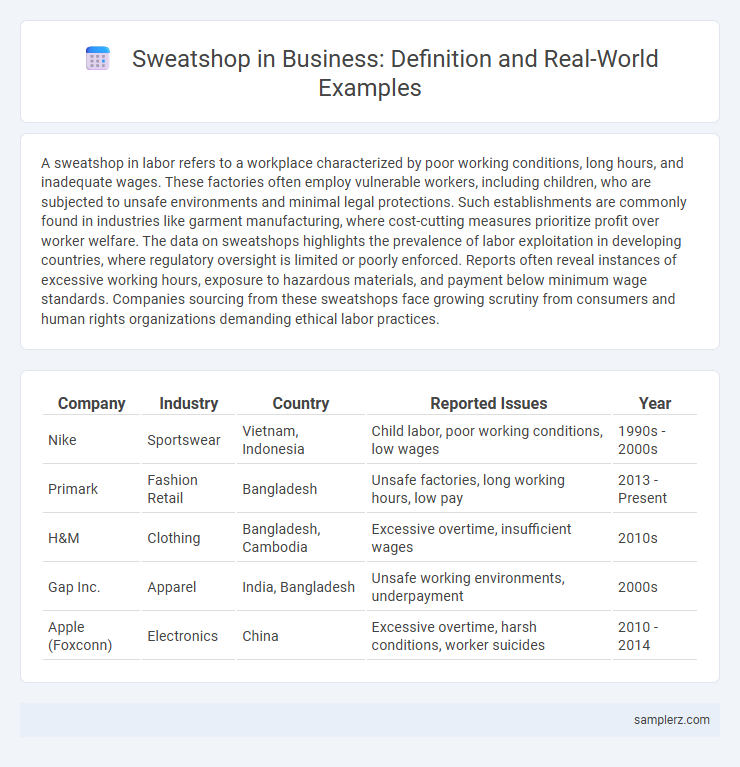A sweatshop in labor refers to a workplace characterized by poor working conditions, long hours, and inadequate wages. These factories often employ vulnerable workers, including children, who are subjected to unsafe environments and minimal legal protections. Such establishments are commonly found in industries like garment manufacturing, where cost-cutting measures prioritize profit over worker welfare. The data on sweatshops highlights the prevalence of labor exploitation in developing countries, where regulatory oversight is limited or poorly enforced. Reports often reveal instances of excessive working hours, exposure to hazardous materials, and payment below minimum wage standards. Companies sourcing from these sweatshops face growing scrutiny from consumers and human rights organizations demanding ethical labor practices.
Table of Comparison
| Company | Industry | Country | Reported Issues | Year |
|---|---|---|---|---|
| Nike | Sportswear | Vietnam, Indonesia | Child labor, poor working conditions, low wages | 1990s - 2000s |
| Primark | Fashion Retail | Bangladesh | Unsafe factories, long working hours, low pay | 2013 - Present |
| H&M | Clothing | Bangladesh, Cambodia | Excessive overtime, insufficient wages | 2010s |
| Gap Inc. | Apparel | India, Bangladesh | Unsafe working environments, underpayment | 2000s |
| Apple (Foxconn) | Electronics | China | Excessive overtime, harsh conditions, worker suicides | 2010 - 2014 |
Notorious Sweatshop Scandals in Global Industries
Notorious sweatshop scandals such as the 2011 Foxconn labor abuses in China exposed widespread worker exploitation in electronics manufacturing, highlighting excessive working hours and unsafe conditions. The 2013 Rana Plaza collapse in Bangladesh resulted in over 1,100 deaths, underscoring dangerous practices in fast fashion garment production. These cases triggered global scrutiny of labor standards and intensified calls for corporate social responsibility in supply chains.
Historical Case Studies of Sweatshop Labor
The 1911 Triangle Shirtwaist Factory fire in New York City revealed harsh sweatshop conditions where workers endured long hours, low wages, and unsafe environments, resulting in 146 deaths that spurred labor reforms. Another notable case is the 1980s Nike factories in Indonesia, exposing exploitation through child labor, hazardous workspaces, and inadequate pay, leading to global protests and changes in corporate social responsibility. These historical examples highlight the persistence of sweatshop labor issues and the ongoing need for regulatory oversight to protect workers' rights.
Modern-Day Sweatshops: Brands and Countries Involved
Modern-day sweatshops are prevalent in countries such as Bangladesh, India, and Cambodia, where major brands like Nike, H&M, and Zara have faced scrutiny for labor violations including low wages and unsafe working conditions. These factories often exploit vulnerable workers in the textile and garment sectors, producing goods for global markets under intense pressure to minimize costs. Persistent reports reveal ongoing challenges in enforcing fair labor standards despite corporate social responsibility initiatives.
Real-Life Worker Experiences in Sweatshops
Sweatshop workers often endure grueling shifts of 12 to 16 hours daily with minimal breaks, facing unsafe conditions and exposure to harmful chemicals. In countries like Bangladesh and Cambodia, garment factory employees report substandard wages far below living costs, forcing many to rely on multiple jobs to support their families. Such environments contribute to chronic health issues and high stress levels, highlighting the urgent need for improved labor rights and enforcement.
Major Apparel Companies Linked to Sweatshop Production
Major apparel companies such as Nike, Adidas, and H&M have been repeatedly linked to sweatshop labor practices involving low wages, unsafe working conditions, and excessive working hours in countries like Bangladesh, Vietnam, and Indonesia. Investigations and reports highlight how subcontracted factories producing garments for these brands often exploit vulnerable workers, including children and women, violating international labor standards. Despite corporate social responsibility commitments, ongoing scrutiny reveals persistent challenges in eradicating sweatshop labor within global apparel supply chains.
Sweatshop Practices in Electronics Manufacturing
Electronics manufacturing often involves sweatshop practices characterized by excessive working hours, low wages, and unsafe conditions, particularly in countries like China, India, and Vietnam. Major tech companies have faced criticism for outsourcing production to factories where labor rights violations occur, including child labor and forced overtime. Efforts to improve transparency and enforce ethical sourcing standards continue to challenge these entrenched exploitative labor conditions.
Child Labor: Shocking Examples in Sweatshop Settings
Sweatshops exploiting child labor often force minors to work in hazardous conditions for long hours with minimal pay, such as in the garment factories of Bangladesh and Cambodia where underage workers endure unsafe environments. Companies like those producing fast fashion brands have faced international criticism after investigations revealed children as young as 10 sewing clothes for global markets. These examples highlight severe violations of labor laws and ethical standards, prompting calls for stricter enforcement and corporate accountability.
Documented Health Hazards in Sweatshop Workplaces
Sweatshop workplaces frequently expose laborers to documented health hazards such as prolonged exposure to toxic chemicals, insufficient ventilation, and repetitive strain injuries resulting from excessive manual labor. Workers often face respiratory issues due to inhaling dust and fumes, while inadequate ergonomic conditions contribute to chronic musculoskeletal disorders. These health risks underscore the urgent need for regulatory enforcement and improved workplace safety standards in global manufacturing sectors.
High-Profile Exposés Unveiling Sweatshop Operations
High-profile exposes such as the 2011 BBC Panorama investigation into Primark factories in Bangladesh revealed poor working conditions, excessive hours, and child labor within sweatshops. The 2013 Rana Plaza collapse further highlighted the dangerous environments forcing global brands like Walmart and H&M to reassess supply chain ethics. These exposes pressured corporations to implement stricter labor standards and increase transparency in garment manufacturing.
The Impact of Sweatshop Revelations on Corporate Reputations
Sweatshop revelations significantly damage corporate reputations by exposing unethical labor practices, including unsafe working conditions and underpaid employees in supply chains. Consumer backlash and activist campaigns often lead to decreased sales and loss of brand loyalty, forcing companies to implement stricter labor standards and transparent sourcing policies. Major brands like Nike and Adidas have historically suffered reputational crises, prompting industry-wide reforms to improve worker rights and corporate social responsibility.

example of sweatshop in labor Infographic
 samplerz.com
samplerz.com